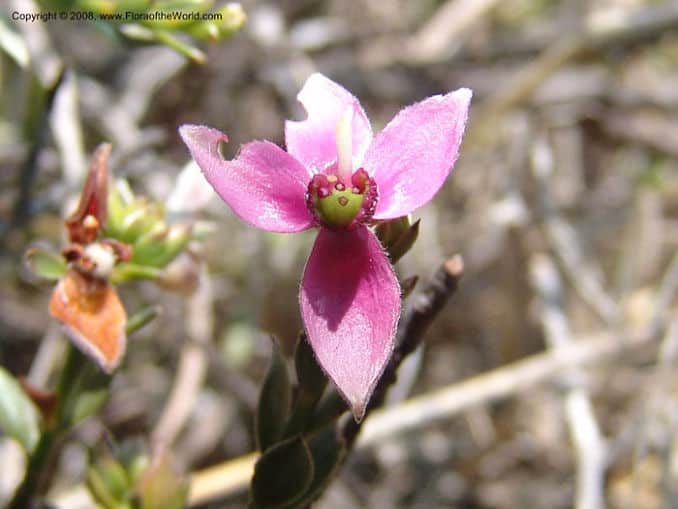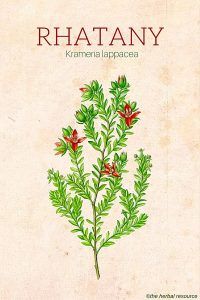Botanical Name: Krameria lappacea.
Other Common Names: Peruvian rhatany, rhatany-root, ratanhia, payta, krameria, mapato (Spanish).
Habitat: Rhatany is found growing wild in Peru, mostly on the western slopes of the Andes, 900-3000 meters above sea level. It can also be found too much lesser extent in Peru’s neighboring countries.
Description: Ratanhia is a shrub that can reach about 90 cm in height. The root stock has wrinkled reddish brown smooth bark and a brown woody core.
The low-lying branches are covered with silky down when they are young and then become woody and knotty as they age.
The leaves are dispersed and sit close together on the branches. They are ovate, 1-2 cm long and covered with silky hair. The flowers are red and each flower has 4 sepals and 4 petals.
Plant Parts Used: It is the roots that are used as herbal medicine.
In Peru, they are harvested all year round from wild growing plants, dried and stored away from light.
The roots are sold mostly in cylindrical pieces of different length and thickness. The roots or the root bark (which has the greatest medical effect) are used to make extracts and alcohol-based tinctures.

Common Therapeutic Uses and Benefits of Rhatany
Active Ingredient and Substances: Rhatany contains around 10-15% tannins (proanthocyanidins and propelargonidins), phlobaphenes (ratanhia-red or krameria-red), neolignanes (ratanhiaphenol), starch, calcium oxalate, etc.
Traditional use of Rhatany
In Peru the rhatany root has been know for its medicinal value for centuries.
In the 1800s it was a tradition among many women in the capital Lima to use the root to whiten their teeth during festivals and other major events.
In traditional South American medicine, the herb was a widely used herbal remedy, especially for oral and dental hygiene.
A Powerful Astringent Herb
Rhatany is a powerful astringent agent and has many useful applications when it comes to shrinking or constricting body tissues naturally.
Internally, an herbal tea made from the root, at low doses, can be consumed in order to treat menorrhagia (heavy or prolonged menstrual periods) and for problems related to the gastrointestinal tract, such as diarrhea, dysentery, inflammation of the stomach and intestine (gastroenteritis), colitis and bleeding in the digestive tract.
External Uses
Externally, compresses or ointments containing rhatany can be applied to minor wounds to halt bleeding, and as an herbal treatment for varicose veins and bruises.
As a remedy for cuts, scrapes or sore nipples a wet gauze can be used.
For vaginal discharge (leukorrhea), the herb has been used in the form of a decoction added to compresses, sitz baths or vaginal douching.
For the treatment of hemorrhoids and anal fissures, a strong decoction of the herb can be used in sitz baths, ointments, or as rectal suppositories containing the powdered root.
Rhatany root extract has been shown to have an antiviral effect on herpes simplex type I, and that it is active against certain bacterias such as Yersinia enterocolitica and Staphylococcus aureus.
A Remedy for Mouth Disorders
Today, rhatany is mostly used as a herbal remedy for ailments related to the mouth and throat.
Diluted rhatany tincture is often used as a mouthwash or a gargle in the treatment of inflammation of the mucous membrane of the mouth, (stomatitis), gingivitis, sore throat (pharyngitis) and inflammation of the tissue around the teeth (periodontitis).
The herb is often added to special kinds of toothpaste that are used to reduce gum inflammation.
The herb’s high content of tannins is responsible for its disinfectant, tonic and firming effect on the mucous membranes of the mouth.
As a remedy for gum inflammation, a concentrated rhatany tincture can also be brushed directly on the gums, or used in combination with tinctures made from other herbs with a good reputation as healing agents for mouth disorders, such as myrrh (Commiphora myrrha) and sage (Salvia officinalis).
One traditional remedy for nasal polyps is to inhale powdered rhatany root and blood root (Sanguinaria canadensis).
Therapeutic Dosages
As a tea: One or two teaspoons of the dried root to one cup water. It is then boiled and allowed to simmer for 10-15 minutes before it is strained. The tea can be drunk 2-3 times daily as a remedy for ailments related to the gastrointestinal tract.
When inflammation in the mouth occurs the tea can be used as a mouthwash or gargle 2-3 times daily.
As a tincture: 1.4 ml can be added in a small amount of water and used 3 times daily. An undiluted tincture can be brushed directly on the affected area 2-3 times daily.
Side Effects and Interactions of Rhatany
No interactions or side effects have been associated with the use of rhatany root as herbal medicine in recommended and small doses.
When the herb is used internally, it can cause minor discomfort and in very rare cases, allergic reactions in the mucous membranes.
It is usually recommended that any internal application of the herb should be discontinued after a few days.
Topical application of concentrated solutions like tinctures or fluid extracts can cause skin irritation in sensitive people.
Supporting References
Bown, Deni: The Royal Horticultural Society New Encyclopedia of Herbs & Their Uses. London, Dorling Kindersley 2002.
Gruenwald, Joerg et al.: PDR for Herbal Medicines. Fourth Edition. Montvale, New Jersey, Thomson Healthcare Inc. 2007.
Hoffmann, David: The New Holistic Herbal. Boston, Element Books Ltd. 1990.
Skenderi, Gazmend: Herbal Vade Mecum. 800 Herbs, Spices, Essential Oils, Lipids Etc. Constituents, Properities, Uses, and Caution. Rutherford, New Jersey, Herbacy Press 2003.
Williamson, Elisabeth M.: Potter’s Herbal Cyclopaedia. Essex, Saffron Walden 2003.
Thordur Sturluson
Latest posts by Thordur Sturluson (see all)
- What is the Difference Between Hemp and Marijuana? - June 3, 2019
